Contact us
Please leave your specific needs and contact information, and the staff will contact you as soon as possible!
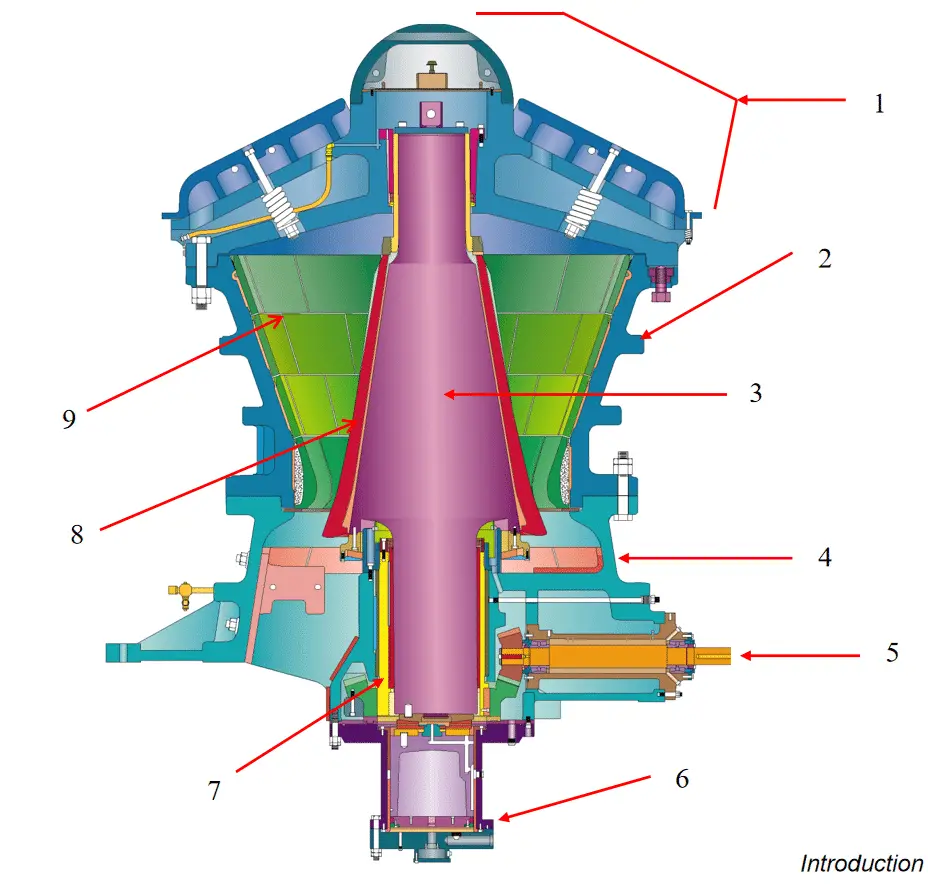
A gyratory crusher is a kind of equipment used to crush large rocks into smaller and more manageable pieces. It is composed of a central upright shaft surrounded by a concave surface referred to as the “bowl,” lined with manganese steel. The gyratory crusher moves the central shaft and generates a conical crushing motion that exerts pressure on the rock against the concave surface.
The main parts of a gyratory crusher include:
The spider assembly is a vital component of a gyratory crusher’s top shell. It is responsible for supporting the primary and secondary crushing surfaces, providing a stable base for the top shell to rest on, and allowing the mainshaft and driveshaft to function smoothly. The assembly consists of multiple components, each with a specific purpose.
The spider arms are the primary support for the crushing surfaces and provide stability for the top shell. The spider bushing is a critical component that fits over the mainshaft, providing a bearing surface for the spider assembly to rotate on. The spider hub is the central hub that connects the spider arms to the mainshaft, enabling them to move together.
The spider assembly also includes several other components, such as the spider cap, spider oil seal, and spider rim liners. The spider cap sits atop the spider assembly, protecting it from wear and tear. The spider oil seal prevents oil leaks from the top shell and ensures that the spider assembly remains lubricated. The spider rim liners are designed to protect the spider arms and hub from the abrasive effects of crushed material.
A well-maintained spider assembly is essential for the proper functioning of a gyratory crusher. Regular inspection and maintenance of the spider assembly can help to extend the life of the crusher and ensure that it operates at peak performance.
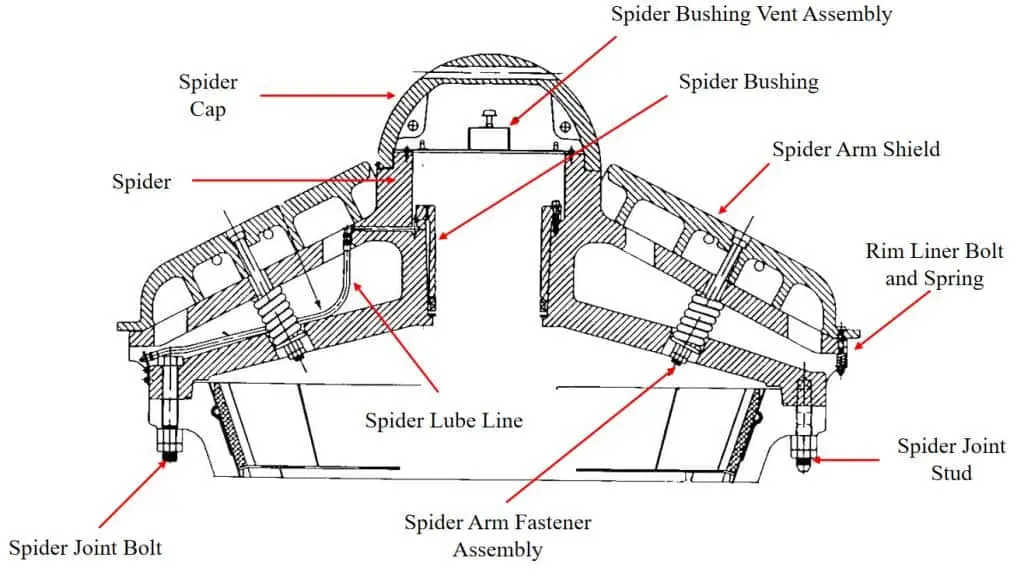
The gyratory crusher is a powerful machine used to crush rocks and other materials. At the heart of this machine is the mainshaft assembly, which is responsible for supporting the mainshaft as it rotates, crushing the material into smaller pieces. The mainshaft assembly is positioned inside the crusher, and it is supported by the spider assembly, which provides the necessary support and stability.
The mainshaft assembly comprises several components, including the mainshaft, the mantle, the spider bushing, the spider cap, and the step washer. The mainshaft is the central component of the assembly, and it is typically made of cast or forged steel. The spider bushing is located in the spider cap and provides support to the mainshaft, ensuring it rotates smoothly.
The mantle is a cone-shaped component that fits over the mainshaft and is held in place by a series of keys and pins. It is typically made of manganese steel, which is highly resistant to wear and tear, ensuring it can withstand the crushing process.
The step washer is a thin metal plate that sits on top of the mainshaft and is used to adjust the position of the mantle concerning the concave or bowl liner. This adjustment is crucial in ensuring the efficient and reliable operation of the crusher.
In conclusion, the mainshaft assembly is a critical component of a gyratory crusher, and it is responsible for ensuring the efficient and reliable operation of the machine. Proper maintenance and regular inspection of the mainshaft assembly are crucial in ensuring safe and efficient operation of the crusher and preventing any downtime that could be costly.
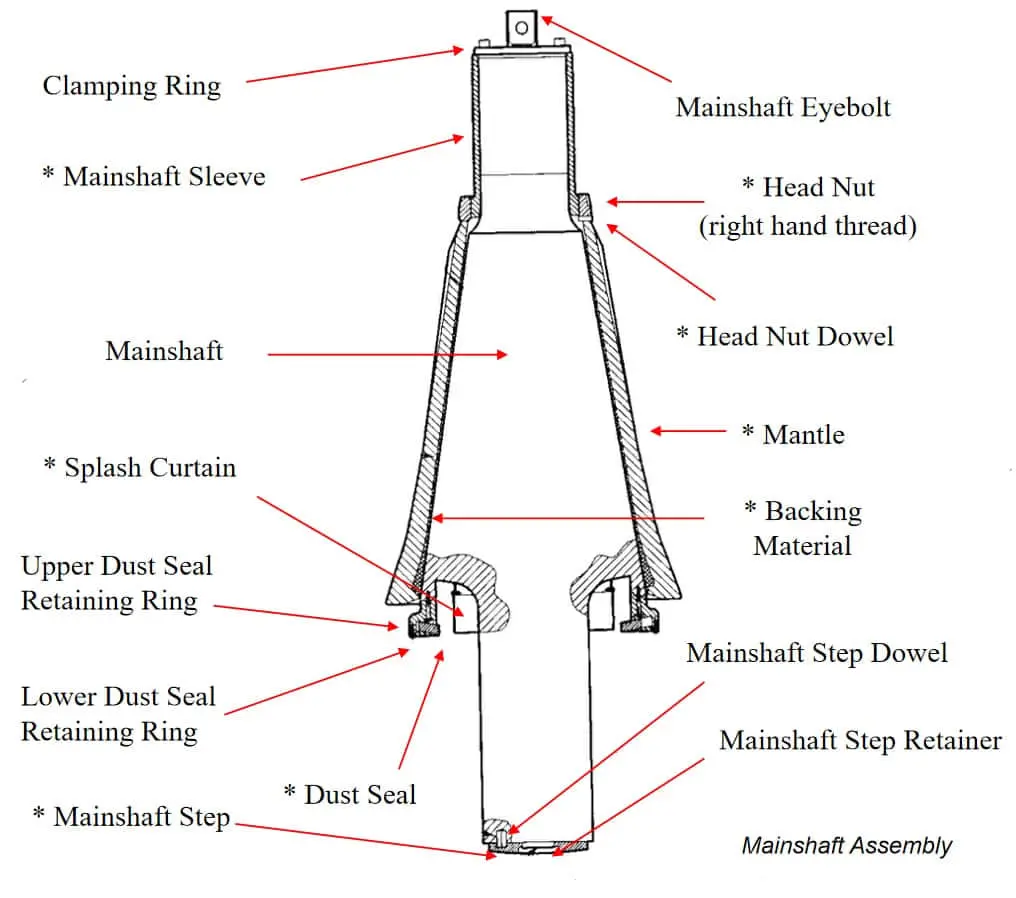
The bottom shell assembly is an essential component of a gyratory crusher. It provides structural support for the entire crusher and supports the mainshaft. The assembly is situated at the bottom of the crusher and consists of the lower half of the shell, a mainshaft step, a hydroset cylinder, and a protective skirt.
The lower half of the shell is typically made of cast steel and is designed to withstand the forces and stresses of crushing rock and other materials. The mainshaft step is a small metal plate that sits on top of the lower half of the shell and is used to adjust the position of the mainshaft relative to the crushing head and mantle.
The hydroset cylinder is a hydraulic component that adjusts the crusher’s setting and maintains the desired crushing chamber profile. The protective skirt is a rubber or plastic component that sits around the bottom of the crusher and helps to prevent dust and debris from escaping the crushing chamber.
Proper maintenance and regular inspection of the bottom shell assembly are essential to ensure the safe and efficient operation of the crusher. Overall, the bottom shell assembly is critical to the gyratory crusher’s operation and must be kept in good condition to ensure reliable performance.
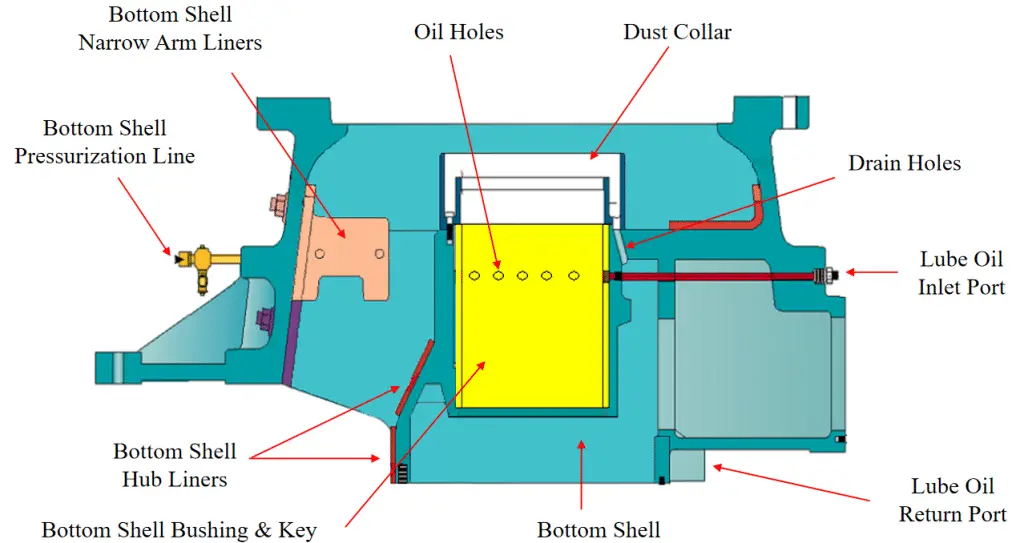
The eccentric assembly located at the bottom of a gyratory crusher is crucial in providing the gyrating motion of the crushing head and mantle. It comprises of three main parts: an eccentric shaft, a bronze bushing, and a bevel gear. The eccentric shaft, a large steel shaft, is driven by the crusher’s motor and supported by the bottom shell assembly. The bronze bushing, located inside the eccentric shaft, provides a low-friction surface for the shaft to rotate against. On the other hand, the bevel gear, made of hardened steel, is attached to the eccentric shaft and is responsible for driving the crushing head and mantle in a gyrating motion.
Overall, the eccentric assembly plays a significant role in ensuring the gyratory crusher operates efficiently and reliably. It is essential to perform proper maintenance and regular inspection of the eccentric assembly to ensure the safe and efficient operation of the crusher.
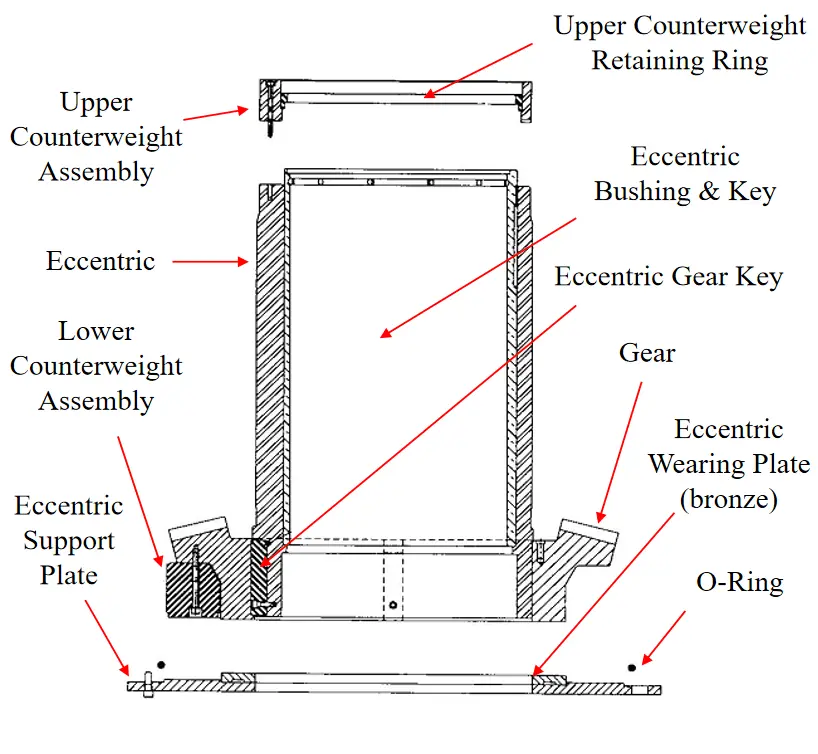
The pinionshaft assembly is a crucial component of a gyratory crusher that provides the necessary rotational motion for crushing rocks and other materials. It is positioned inside the crusher and supported by the mainshaft assembly.
The pinionshaft assembly comprises a pinion shaft, a pinion gear, a bearing, and a keyway. The pinion shaft is a long and thin steel shaft that is supported by the mainshaft assembly and responsible for transmitting the rotational motion from the crusher’s motor to the crushing head and mantle.
The pinion gear is a small metal gear attached to the pinion shaft that meshes with the bevel gear of the eccentric assembly to provide the gyrating motion of the crushing head and mantle.
The bearing is a component that supports the weight of the pinion shaft and enables it to rotate smoothly. The keyway is a small channel cut into the pinion shaft that holds the pinion gear in place.
In summary, the pinionshaft assembly is a vital component of a gyratory crusher, and it plays a crucial role in ensuring the efficient and reliable operation of the crusher. Proper maintenance and regular inspection of the pinionshaft assembly are necessary to ensure the crusher’s safe and efficient operation.
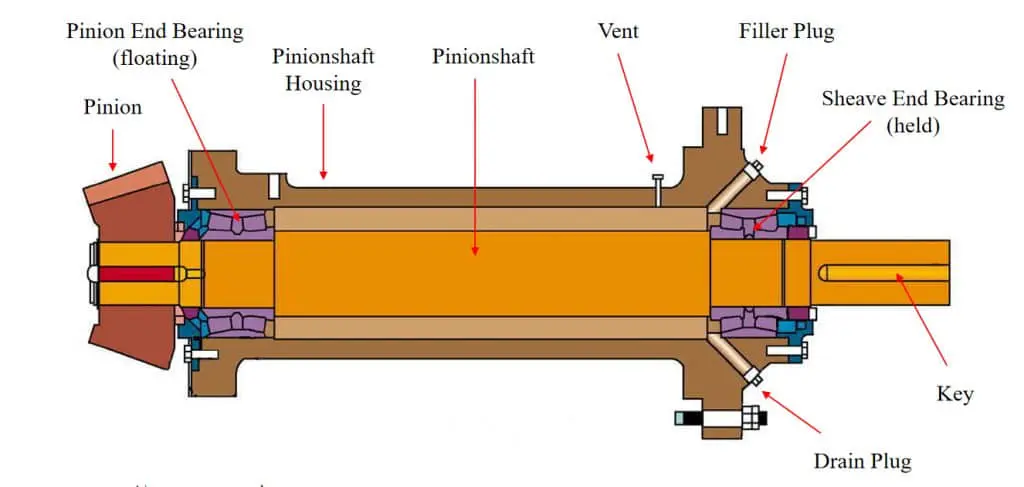
Gyratory crusher liners are essential components of the gyratory crusher, which is primarily used for crushing materials in the mining industry. These liners are responsible for safeguarding the mainframe and other internal components of the crusher from wear and damage caused by the crushing process.
Typically, these liners are made of high manganese steel, a durable and wear-resistant material that can withstand the high impact and abrasion of the crushing process. They are designed to be easily replaceable as they tend to wear out over time due to the constant friction and impact of the materials being crushed.
The primary function of the gyratory crusher liners is to extend the life of the crusher by protecting its internal components from wear and tear. By doing so, they help reduce the need for costly repairs and maintenance. Additionally, these liners can also improve the crushing process’s efficiency by reducing the amount of material lost due to wear and increasing the machine’s overall throughput.
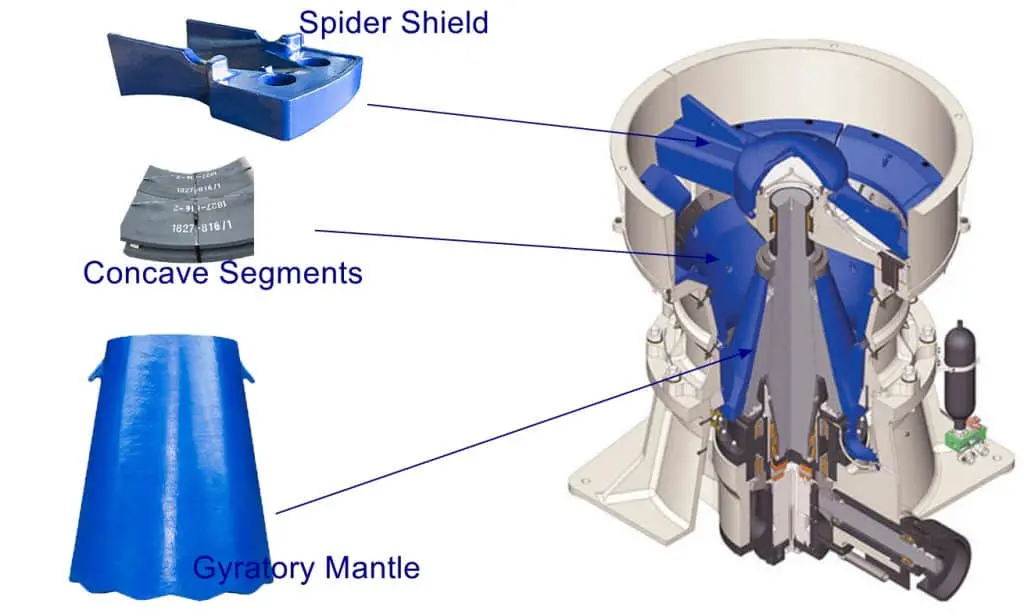
Qiming Casting is a renowned manufacturer of various kinds of gyratory crusher wear parts, including liners, mantles, spider caps, and spider arms. These components have a crucial role in size reduction of rocks during the crushing process, as they are used in primary crushers. Qiming Casting’s gyratory crusher parts are designed to offer the highest possible wear life while ensuring mechanical reliability. This is essential for mine operations, as production stops can prove to be very expensive.
Qiming Casting’s manganese gyratory crusher wears are easy and quick to install, making them a reliable and efficient choice. The mantle wear parts, made of manganese steel, come in different shapes, surface profiles, and steel grades, and are designed for the hardest rocks in surface and underground operations.
Additionally, Qiming Casting also offers alloy steel, TIC inserts, and manganese steel concave wear parts for various applications.
We offer a wide range of mantle designs, including smooth one-piece options, as well as larger, full-toothed two-piece or three-piece solutions. These teeth can be placed at almost any level on the mantles, thereby improving the nip. Our users have reported that teeth greatly reduce slippage and improve production, as well as liner wear life.
Additionally, we have designed TIC inserts gyratory mantle specifically for our customers. Based on this design, our TIC insert mantle has a lifespan of 2-3 times more than that of a normal manganese gyratory mantle.
We use the strongest alloy that can withstand the impacts of a particular gyratory application. The choice of alloy depends on the compressive strength, toughness, and friability of the material being crushed.
For instance, crushing tougher materials requires work-hardening manganese steel. However, using the same liners for an abrasive and easily crumbled ore may lead to quick wear because there are insufficient impacts to cause the surface to work harden.